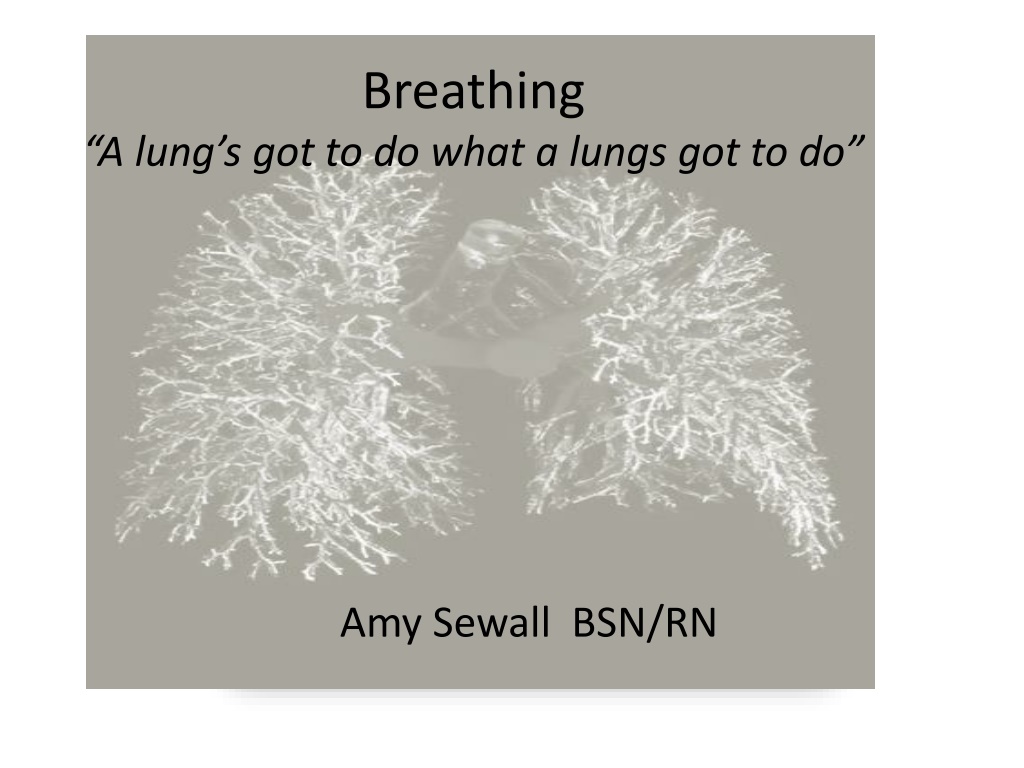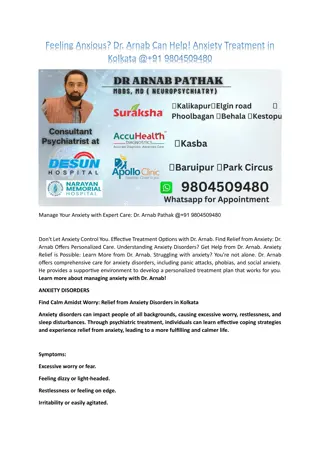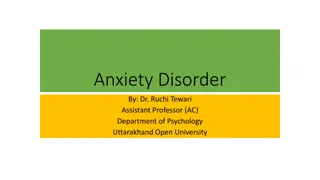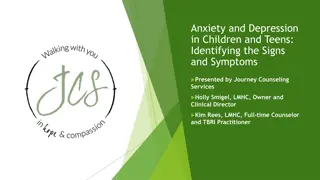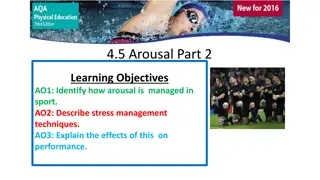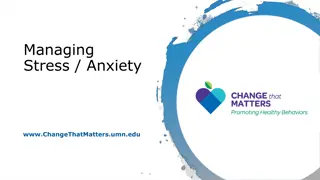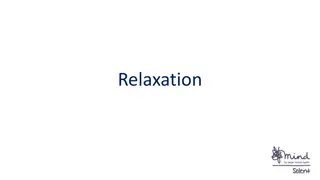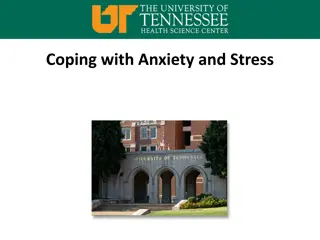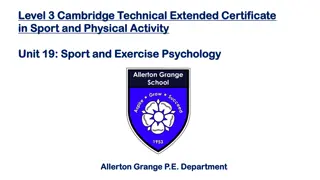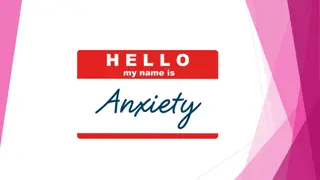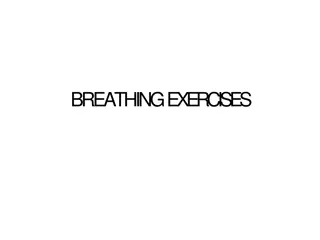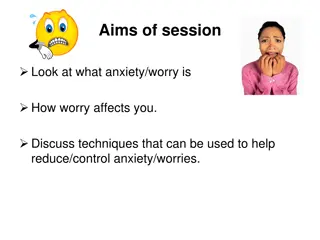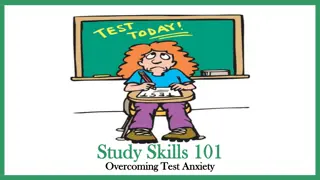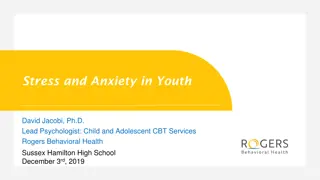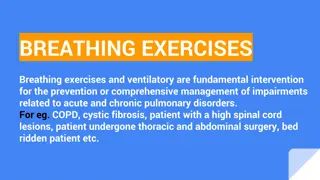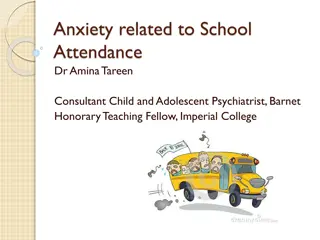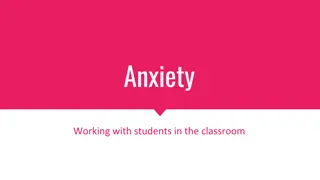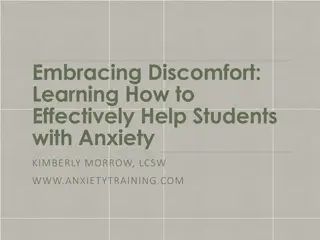Understanding Breathing, Anxiety, and Stress Management
Explore the crucial role of breathing in supplying oxygen to the body and expelling carbon dioxide, learn about anxiety disorders affecting millions, understand stress and its impact on health, and discover effective stress management techniques like setting boundaries and seeking social support. Remember, managing stress is essential for overall well-being!
Download Presentation

Please find below an Image/Link to download the presentation.
The content on the website is provided AS IS for your information and personal use only. It may not be sold, licensed, or shared on other websites without obtaining consent from the author. Download presentation by click this link. If you encounter any issues during the download, it is possible that the publisher has removed the file from their server.
E N D
Presentation Transcript
Breathing A lung s got to do what a lungs got to do Amy Sewall BSN/RN
Agenda Breathing Overview Anxiety Hyperventilation Stress/Anxiety Reduction Methods Relaxation Techniques Note: Check with a physician before starting any exercise
Breathing - Overview Average of 3K to 5K gallons of air every day 2 Things accomplished: 1. Supplies body with oxygen to burn food, release energy and for organs to work properly. 2. Expels Carbon Dioxide (waste product of the body s metabolism) Breathing Process
Breathing Process Continued Blood is the highway for nutrients to and from the body Bottom Line: VERY IMPORTANT FOR YOU TO LIVE AND BE HEALTHY
Anxiety Nearly 40million people in the United States have suffered from panic attacks or other anxiety disorders in the past year. Nearly a quarter of the adult population will suffer from an anxiety disorder at some time during their life.
What is Stress? Stress is different for each of us. What is stressful for one person may or may not be stressful for another; each of us responds to stress in an entirely different way.
Is Stress Bad? Stress is to the human condition what tension is to a violin string.
How Do You Manage Stress? Talk with Support Network. Set a schedule. Schedule breaks. Find healthy ways to manage stress. Set Boundaries. Get to know others who share your goals, who have qualities which to admire, and who are willing to help.
ASK FOR HELP! Monitor your stress level and seek help if you experience time management problems, social isolation, concentration difficulties, physical or emotional symptoms. Seek early assistance..problems become more difficult to manage the more they go on.
Hyperventilation Common Causes: Anxiety Panic ( Air Hunger ) Stress Signs and Symptoms of Hyperventilation: 1. Light Headedness 2. Dizziness 3. Sweating 4. Rapid Heart Rate 5. Tingling and Numbness in Hands and Feet 6. Chest Pain
Relaxation Techniques (Just Breathe) Breathing is Natural tranquilizer Breathing: Detoxifies and releases toxins Releases tension Relaxes mind and body/ brings clarity Increases muscles Strengthens immunes systems
4-7-8 Relaxation Breathing Exercise Dr. Andrew Weil Sit with back straight Place the tip of tongue against ridge of tissue just before upper front teeth Exhale completely through mouth making whoosh sound Close your mouth and inhale quietly through your nose to the mental count of 4 Hold breath for count of 7 Exhale completely through your mouth making the whoosh sound to the count of 8 Repeat cycle 3 more times for a total of 4 breaths. Do not do more than 4 breaths at one time.
Abdominal Breathing Exercise Place one hand on your abdomen right beneath your rib cage Inhale slowly and deeply through your nose into the bottom of your lungs. If you are breathing from your abdomen, your hand should actually rise When you have taken in a full breath, pause for a moment and then exhale slowly through your nose or mouth. As you exhale, allow your whole body to let go (limp like a rag doll) Do ten slow, full abdominal breaths. Try to keep your breathing smooth and regular. Slow inhale..pause slow exhale..10 Slow inhale..pause slow exhale..9
Progressive Muscle Relaxation Tensing particular muscle groups for 7 to 10 seconds Concentrate on what is happening...feel the buildup of tension. Release the muscle abruptly and then relax for 15 to 20 seconds before going to the next muscle group. Muscle groups to work: fists, biceps, triceps, forehead, eyes, jaw, back of neck, shoulders, chest, stomach, lower back, buttocks, thighs, calf muscles and toes.
